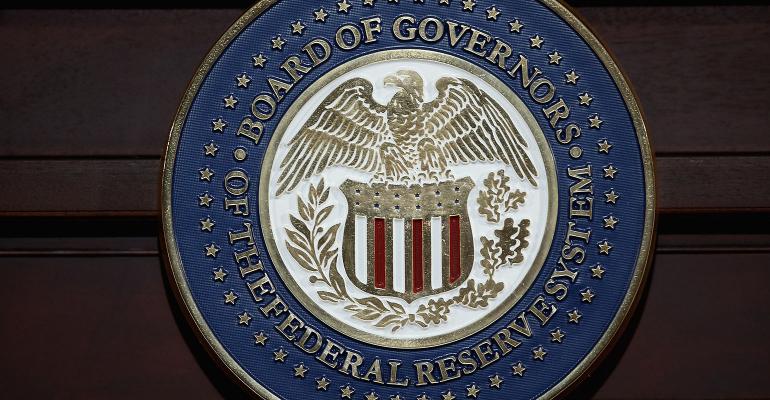By Craig Torres and Christopher Condon
(Bloomberg) --The Federal Reserve raised its benchmark lending rate a quarter point and continued to project two more increases this year, signaling more vigilance as inflation approaches its target.
“In view of realized and expected labor market conditions and inflation, the committee decided to raise the target range for the federal funds rate,” the Federal Open Market Committee said in its statement Wednesday. “Near-term risks to the economic outlook appear roughly balanced.”
Investors had almost fully expected the increase to a range of 0.75 percent to 1 percent following unusually clear signals from policy makers including Chair Janet Yellen, who began a press conference at 2:30 p.m. in Washington.
“I’m a little bit surprised” Fed officials continued to forecast a total of three rate increases this year, said Daniel North, chief economist at credit insurer Euler Hermes, in Owings Mills, Maryland. “Inflation is rising, so I’ve been thinking they would project four hikes to keep the financial markets prepared” for a more rapid pace of rate moves.
Yields on two-year U.S. Treasuries declined about 5 basis points to 1.32 percent at 2:19 p.m. in New York and 10-year yields fell 7 basis points to 2.53 percent. The S&P 500 Index of U.S. stocks was up 0.7 percent at 2,381.52.
The U.S. economy has mostly met the central bank’s goals of full employment and stable prices, and may get further support if President Donald Trump delivers promised fiscal stimulus.
For now, officials stuck with their “gradual” approach to tightening monetary policy, while removing the word “only” when a previous statement called the approach “only gradual.” Central bankers left unchanged their median projections for three quarter percentage-point increases in 2018, while the median fed funds rate estimate for 2019 rose to 3 percent from 2.9 percent.
They made several changes to their language on inflation.
“The committee will carefully monitor actual and expected inflation developments relative to its symmetric inflation goal,” the Fed statement said. “The committee expects that economic condition will evolve in a manner that will warrant gradual increases in the federal funds rate.”
Inflation, Unemployment
The committee described job gains as “solid” and said business investment “appears to have firmed somewhat.” Inflation, the statement said, is “moving close” to the committee’s 2 percent target.
On March 3, Yellen said the scaling back of monetary stimulus won’t be as slow as 2015 and 2016, when the Fed delivered only two increases.
Minneapolis Fed President Neel Kashkari voted against the decision to hike rates, dissenting in favor of a hold. He was the only contrary vote on the committee.
Inflation was forecast to reach 1.9 percent in the fourth quarter this year, and 2 percent in both 2018 and 2019, according to quarterly median estimates released with the FOMC statement. The Fed’s preferred measure of inflation rose 1.9 percent in the 12 months through January, just shy of its target.
Officials projected unemployment to finish this year at 4.5 percent, unchanged from the December forecast. That’s a sign that they expect to overshoot their estimate for maximum use of labor resources, which they put at 4.7 percent, down from 4.8 percent in December. Unemployment was forecast to end 2018 and 2019 at 4.5 percent. The jobless rate was 4.7 percent in February.
U.S. central bankers left unchanged their forecast for 2017 GDP growth at 2.1 percent. The median estimate showed the economy expanding 2.1 percent in 2018 and 1.9 percent in 2019, compared to 2 percent and 1.9 percent in the December forecast.
Confidence Soared
The third rate hike since the 2007-2009 recession was well telegraphed, following comments in recent weeks from officials including Vice Chairman Stanley Fischer and New York Fed chief William Dudley, who called the case for a March move as “a lot more compelling.”
Investor and business confidence has soared since Trump won the U.S. presidency in November, buoyed by his vows to cut taxes, lift infrastructure spending and ease regulations.
Still, economic data don’t show an economy that’s heating up rapidly. Retail sales in February grew at the slowest pace since August, a government report showed earlier Wednesday. The Atlanta Fed’s model for GDP predicts an expansion of 0.9 percent in the first quarter, less than a third the pace Trump is aiming for.
Yet some Fed officials have already upgraded their forecasts in anticipation of some form of boost to the economy from the new administration.
Details, though, remain scant and must be passed by Congress, where his Republican Party controls both chambers and may include members wary of steps that lift the U.S. deficit.
To contact the reporters on this story: Craig Torres in Washington at [email protected] ;Christopher Condon in Washington at [email protected] To contact the editors responsible for this story: Brendan Murray at [email protected] Alister Bull, Randall Woods





